

GeneticsGenetic Differences
between Western bred Sighthound (FCI group 10) and
Primitive breeds (FCI group 5) In the current absence of any scientific peer reviewed publication about these results, we are limited to the data presented at the talk given by Dr.Wimmer at a meeting of the DWZRV in December of 2012 and summarized for some of the breeds by Ursula Arnold (look under each breed for the links). Both documents are in German. We provide here a summary in English to enable these results to be understood outside of Germany. Lecture by Dr.Wimmer, 2012, about Sighthounds DNA as revealed by microsatellites The following breeds were studied with about 21-27 samples per breed. The German Breeding Commission was asked to propose 40 dogs of each breed which represent the breed standards and are preferably not closely related. The Directors of the breeding commission ("Zuchtleitung") then decided and chose 25 dogs as best representatives (criteria for choosing all these dogs is given only for some). Most of the dogs in this study are German bred, except the breeds whose results are based on prior and new samples FCI Group 10: Sighthound Breeds ; Afghan Hound (24), Azawakh (25), Borzoi (25), Chart Polski (25), Scottish Deerhound (25), Galgo espanol (25), Greyhound (25), Irish Wolfhound (23), Magyar Agar (27), Saluki (25), Sloughi (24), Whippet (25), Italian Greyhound (25) FCI group 5: Primitive breeds: Pharaoh Hound (25), Cirneco del Etna (23), Ibizan (Podenco Ibicenco) (21), Podenco Canario (23), Podenco Portugues pequeno (25), Podenco Portugues medio (21) Method: cheek swabs were taken from both males and females to collect the DNA needed to study the microsatellites. For this study 9 markers were used (FHC 2010, FHC 2054, PEZ 1, PEZ 12, PEZ 20, PEZ 5, FHC 2079, PEZ 6, PEZ 8) and 321 SNIPS. Prior to this study, these markers and SNIPS were tested and established by Mars for a test to determine the breeds involved in crossbreed dogs prior to this study - when owners want to know "what their dog is made of". General Results
1) Sighthounds and Primitives compared to non sighthound (Affenpinscher) When compared to a non Sighthound breed such as the Affenpinscher, all the Sighthounds and Primitives in this study shared more genetic similarities with each other than they did to that outside breed (page 20 of the lecture). 2) Relationships between breeds This study reveals that some of the breeds are closer than others. - Sloughi and Azawakh - Sloughi and Galgo espanol - Saluki and Afghan Hound - Scottisch Deerhound and Irish Wolfhound; both stand apart from the other Sighthounds - Borzoi and Chart Polski - Greyhound and Magyar Agar - Whippets and Italian Greyhound - Primitives (FCI Group 5) and Galgo or Sloughi (mediterranean breeds) Results FCI Group 10: Sighthounds
SLOUGHI &
AZAWAKH & GALGO ESPANOL
Sloughi © de Caprona Results Sloughi Because this website is about the Sloughi, let us start with the results concerning this breed. See also the summary written here in German Sloughi results in Dr. Wimmer's study by Ursula Arnold Samples: 29 Sloughi samples were received that came from 6 German kennels, 1 Czech, one French and one American kennel. Only one sample was of North African breeding, a Moroccan Import. In other words, a total of 25 German samples and 4 samples not bred in Germany. In the end 24 samples were used. One does not know which of the samples were removed and for what reason. Sloughi and other dog breeds The results of the Sloughi samples cluster separatly from the mass of the all dog breeds cluster (a cluster is how the results of all samples of a breed or type of dog group together away from the results of other breeds) except for 3 samples (page 37 Dr. Wimmer). The Sloughi is thus distinct from other breeds of dogs but also from other Sighthounds. The cluster built by the samples is not very tight tending to show that Sloughis are not highly inbred. One individual is located between Sloughi and Azawakh and was removed under the assumption that it is a cross between Azawakh and Sloughi: how such a decision could be taken in the absence of a data bank on North African Sloughis to compare it with is a mystery. Sloughi versus Saluki, Azawakh and Galgo espanol The Saluki's more numerous samples were a mix of older samples from a previous data bank from Salukis in the UK and the USA, and recent samples (25) from Germany. The Azawakh and the Galgo espanol samples were like the Sloughi samples "new samples", there was no older data bank for them. These four breeds are clearly distinct from one another as shown by their clusters (page 32 Dr. Wimmer). Of these breeds the Sloughis of this study, although distinct, are on the one hand closer to the Azawakh, which comes as no surpise as both originate in Africa, and on the other hand with the Galgo espanol from Morocco's neighboring country of Spain. The Sloughis sampled in this study appear to be a link between African and other Mediterranean breeds. Sloughi versus Podengo Portugues medium size and Galgo espanol Sloughi and Galgo espanol form distinct clusters separated from each other. Interestingly several samples of the Podenco Portugues medio are found to group between the Sloughi and the Galgo, although several other samples cluster clearly away from the Galgo and the Sloughi (page 5 Arnold). This would tend to show that at some point in the history of these breeds (or the breeding of the dogs tested itself) - Podenco portugues of medium size, Sloughi and Galgo - some admixture took place, but it is difficult to know in which direction that admixture happened, when and where it happened. The Podenco Portugues pequeno (small) on the other hand is clearly distinct and forms its own cluster away even from the Podenco Portugues medio. Within the Mediterranean breeds, the for-the-most-part-German-bred Sloughis in this study are closer to the Galgo and some samples of the Portugese Podenco medio than to any of the following: Pharaoh Hound, Cirneco dell' Etna, Ibizan, Podenco Canario and Podenco Portugues pequeno. Although these results are promising in that they show that Sloughi/Saluki/Azawakh and Galgo espanol are genetically distinct from one another, one cannot help but think that it would have been a good idea to develop a data base of DNA samples collected on North African Sloughis in Morocco, Algeria and Tunisia. There is only one Moroccan sample in this study and it is not clear whether it is part of the results or has been discarded. Sloughis from Algeria and Tunisia live further away from the Iberian Peninsula than the Moroccan Sloughis do, and they should be part of such a data bank.This North African Sloughi data base could then have been compared with the Western bred Sloughis to establish how close these Western bred Sloughis are to the original breeding stock in Africa. We know of the various influences of dogs either of unknown origins or other breeds which were mistakengly incorporated into the Sloughi breeding in the early stages of the Sloughi Renaissance in the Western World. For more information please read this article. As it stands, an alleged "Sloughi breed specific" genetic test based on a majority of German bred Sloughi samples would ONLY give some insight as to whether the dog tested fits to the DNA profile of the German bred Sloughis. It is at the moment a "German bred Sloughi specific" test. In the absence of any North African bred Sloughi genetic data base to compare the dog with, this test will NOT determine whether a dog tested fits to the genetic profile of the North African bred Sloughi. 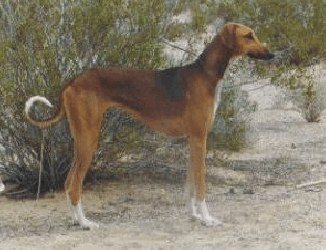 Azawakh © McGuffin Results Azawakh Azawakh results in Dr. Wimmer's study by Ursula Arnold 26 samples were received, 25 were selected, one was removed because it was closely related to the others. These samples came from 12 kennels, 5 German, 1 in the Netherlands, 1 in France, 1 in Portugal and one in the Czech Republic. 8 of these samples showed no recent import in their pedigrees, 10 were second generation import (different imports), 5 were half African, 2 were imports from Central Africa. The Azawakh's results cluster separatly from other dog breeds (page 6 Arnold) and from Sloughi and Saluki (page 5 Arnold). Of all the Sighthounds in the study, it is closest to the results of the Sloughi, which in the countries of origin is found on the same continent but North of where the Azawakh originates. When compared to other breeds, a Basenji and an Azawakh sample show some genetic proximity. This may result from the fact that these 2 breeds are closer geographically in their countries of origin (page 37 Dr. Wimmer). 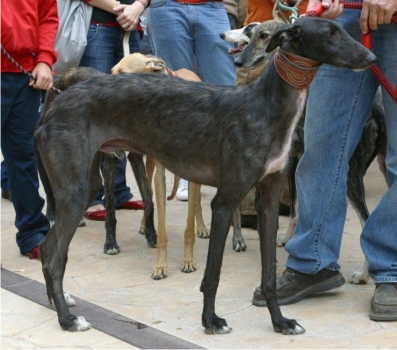 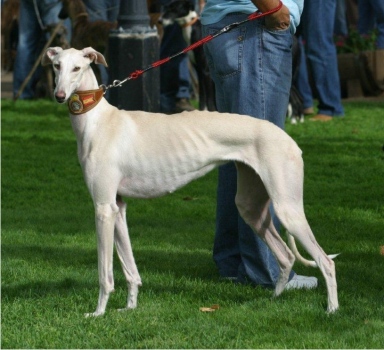 Galgo espanol wirehair and smooth © Gaede Results Galgo espanol Galgo espanol results in Dr. Wimmer's study by Ursula Arnold 26 samples were used. 21 samples came from 11 kennels (no indication of country), and 5 had no kennel name. They all represented the coat colors and hair type (wire and smooth) allowed by the standard. The results of the Galgo espanol cluster away from all breeds and from other Sighthound breeds. They are closer to the results of the Sloughi than to other Sighthound breeds. They are also close to some of the samples of the Podenco portugues medio. AFGHAN HOUND & SALUKI
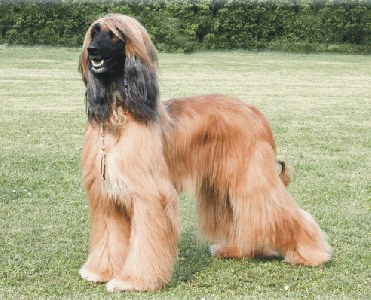 Afghan Hound © R. Schwab Results Afghan Hound Afghan results in Dr. Wimmer's study by Ursula Arnold 52 samples were obtained from Afghan hounds bred in 24 kennels (Germany, USA, Australia, France) out of which 24 samples of this breed were used and compared to prior Afghan hound samples from the United Kingdom as well as with those of other breeds. How these 24 samples were chosen is unclear. The samples from the Afghan Hound breed shows that both older and new samples cluster tightly, indicating a very homogenous genetic background, probably resulting from a high degree of inbreeding. The Afghan hound is clearly distinct from the Saluki, the Sloughi and the Azawakh. (Page 5 Arnold). Of all these breeds it is closer to the Saluki. 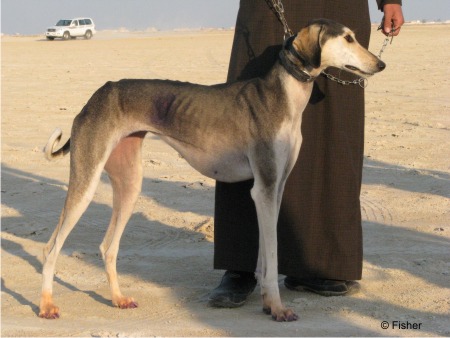 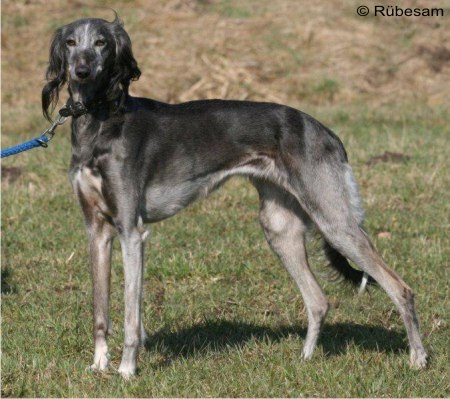 Saluki smooth © Fisher and feathered © Ruebesam Results Saluki Saluki results in Dr. Wimmer's study by Ursula Arnold 35 samples were collected out of which 25 were used for the study (10 samples were removed on the basis of their close relationship to others). These samples came from 14 German kennels, 1 from the UK, 1 from France, 1 from the Netherlands, 1 from Sweden, 2 from Switzerland, 4 from the USA. They represented both coat types, feathered and smooth, and some were half imports from countries of origin (countries not indicated nor how many were half imports) This study shows that the Saluki's results cluster away from all other breeds of dogs, and that they cluster away from Azawakh and Sloughi (page 4 Arnold). Interestingly, the prior UK Salukis samples form a much larger cluster than where the DWZRV samples actually fit in. It could be that the foundation Salukis in the UK have been imported from very different countries of origin over a large geographical area. The samples in this study cluster only with some of the UK samples showing perhaps a less varied geographical origin of the 24 Salukis selected for this study . SCOTTISH DEERHOUND
& IRISH WOLFHOUND
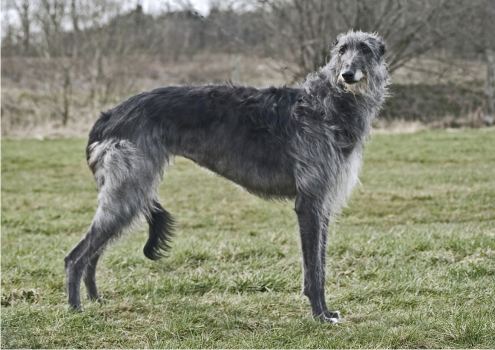 Scottish Deerhound © R. Schwab Results Scottish Deerhound Deerhound results in Dr.Wimmer's study by Ursula Arnold 34 samples were sent in, of which 25 were chosen as being the least related possible. The samples came from 13 German kennels and 2 British kennels. The results of these samples were compared with prior samples from UK Deerhounds and with other breeds. The cluster formed by Deerhound older and new samples is very tight, showing good homogeneity and probably a high degree of inbreeding. The results of the Scottish Deerhound stand away from other dog breeds and away from other Sighthound breeds. They also show that the Deerhound is distinct from the Irish Wolfhound, although they are closer to the Irish Wolfhound results than to other Sighthound breeds. One Deerhound sample stands between both breeds and was discarded (why? is the question). 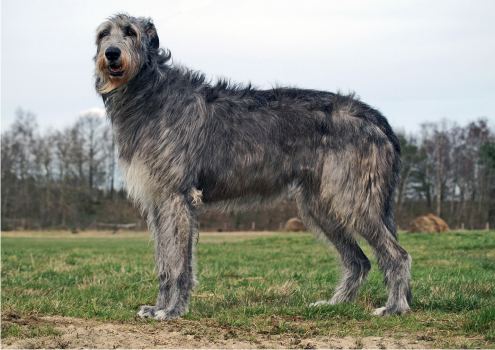 Irish Wolfhound © R. Schwab Results Irish Wolfhound Irish Wolfhound results in Dr.Wimmer's study by Ursula Arnold 23 samples were received, of which 2 were closely related. They came from 18 German and International kennels (no indication is given as to how many German kennels). The Irish Wolfhound samples show results which cluster tightly with prior samples from the UK, indicating a homogenous background and probably inbreeding on few founders. The cluster is distinct from all dog breeds (page 5 Arnold), from all sighthound breeds and from the Scottish Deerhound (page 4 Arnold). However the Irish Wolfhound results are closer to the Scottish Deerhound than to any other breed. BORZOI &
CHART POLSKI
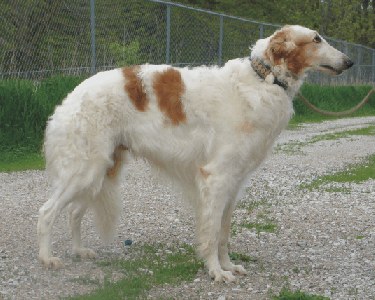 Borzoi © de Caprona Results Borzoi Borzoi results in Dr.Wimmer's study by Ursula Arnold 27 samples were received out of which 25 were sent to the study, 2 were kept in reserve should a sample be of poor quality. The samples came from 17 kennels which have basically nothing to do with one another. No information is given as to where the kennels are located (Germany or other countries as well?) These samples were compared to previous samples taken in the UK. The results of the Borzoi cluster tightly with the previous UK samples, showing homogeneity in the breed. They are clearly distinct from the results of other breeds of dogs (page 4 Arnold) and from other breeds of Sighthounds. Although distinct, Borzois are closer to the results of the Chart Polski than to other Sighthound breeds, which makes sense considering the geographical proximity of the countries of origin. 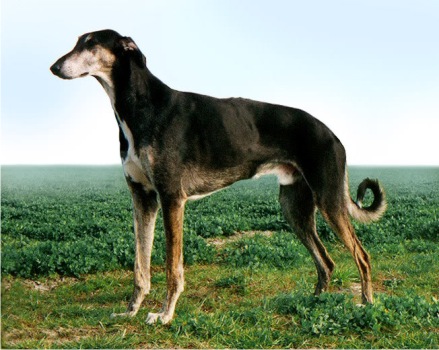 Chart Polski Results Chart Polski No separate summary is given regarding the results of this breed. We only know that 25 samples were sent for the study. There is no information as to where they came from. Dr Wimmer's talk shows that the Chart Polski has its own cluster of results distinct from other breeds of dogs or Sighthounds and from the Borzoi. Although different from one another Chart polski and Borzoi are closer to each other than to other Sighthound breeds. GREYHOUND & MAGYAR AGAR
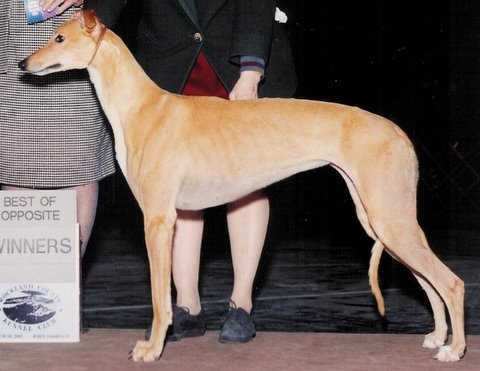 Greyhound © Karen Lorenzo Results Greyhound Greyhound results in Dr.Wimmer's study by Ursula Arnold 27 samples from 19 kennels were received and 25 selected for the study, 2 were removed because of tight relationship to others (no indication as to the countries of these kennels). Of these 25 samples, 15 were of racing lines, 10 were of show lines. Prior samples had been collected in the UK and the USA by MARS. Greyhound results show that they are clearly distinct from other breeds of dogs, other breeds of Sighthounds and from the Magyar Agar. The results of the Greyhound itself are interesting in that the samples of racing Greyhounds of this study group together with the UK and USA samples, whereas the 10 samples of show Greyhounds form their own cluster away from that of the racing/UK/USA samples. It would have been interesting to compare the results of the show Greyhounds of this study to those of the show Greyhounds elsewhere. In the USA very few breeders cross show to racing greyhounds. The result has been a divergence in the looks of the dogs. It is very possible that the racing Greyhound and the show Greyhound have drifted away from each other genetically because of selective breeding for many generations that separated these 2 populations from one another, and this selective breeding could thus have resulted in what one sees in the graphs. It is also a well known fact that show Greyhounds in the US are highly inbred, but there is no details given as to the relationship of the show Greyhounds of this study with the show Greyhounds in other countries. The Racing Greyhound results are closer to the results of the Magyar Agar than those of the show Greyhound are to the Magyar Agar. The racing Greyhound results are closer to the Magyar Agar than to the show Greyhound. 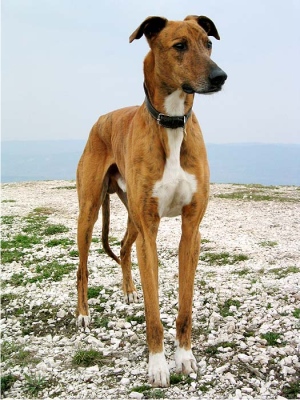 Magyar Agar © Kacer Results Magyar Agar There is no summary for this breed at this time. The results are included in the summary of Greyhound results and Dr.Wimmer's talk 27 samples were sent to the study (no details about kennels and their countries). The results show that the samples of the Magyar Agar cluster away from other breeds of dogs (page 37 dr.Wimmer). The breed is also distinct from other Sighthounds and from the Greyhound. The results cluster far away from the show Greyhound (page 27 dr.Wimmer), whereas some of the samples are closer to the UK/racing Greyhound cluster. ITALIAN GREYHOUND &
WHIPPET
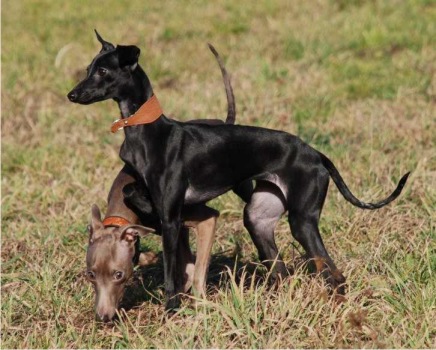 Italian Greyhounds © Cora Nuernberger Results Italian Greyhound Italian Greyhound / Whippet results included in Dr. Wimmer's study by Ursula Arnold 39 samples were sent in, representing 14 kennels (no indication of country), out of which 25 were chosen for the study; the others were sorted out because they were to closely related. These new samples were compared with prior samples collected in the United Kingdom. The results of this breed are distinct but form 2 clusters: one for the dogs in this study, and one for the the UK samples. These 2 clusters are not far from each other (page 4 Arnold). Both of these clusters are distinct from other breeds of dogs (page 38 Dr.Wimmer) and other breeds of Sighthounds, particularly from the Whippet, the Greyhound and the Magyar Agar (page 5 Arnold). These 2 clusters would tend to show some Genetic Drift having occurred between the population of Italian Greyhounds on the British Isle and the population on the European continent, if there was little or no breeding between these 2 populations. 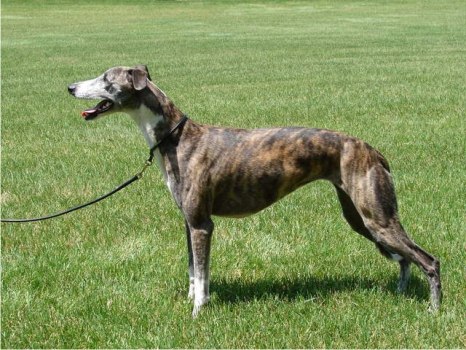 Whippet © Gail Wieberdink Results Whippet There is no summary for this breed at the moment, the results are compared to the Italian Greyhound in the link above. 25 samples were sent to the study (no indication as to where they came from). The results of these Whippets were compared to prior results from the United Kingdom and from the USA. These results show an interesting picture. The samples of this study cluster together with the samples collected before in the United Kingdom. However, they cluster away from the neighboring cluster formed by the results of the Whippets sampled in the USA. Grouping the results of these 3 populations shows that they are distinct from other breeds of dogs (page 38 Dr.Wimmer). Compared to Greyhound, Magyar Agar and Italian Greyhound, it seems that 4 of the new samples are situated between the UK/Recent samples cluster and that of the Magyar Agar (page 5 Arnold). Here again Genetic Drift may have taken place between the USA Whippets and the European Whippets, if there was some extensive breeding isolation between these 2 populations. Results FCI Group 5 : Primitives No summaries are available at this time for these breeds, so we refer here to the Dr.Wimmer's lecture 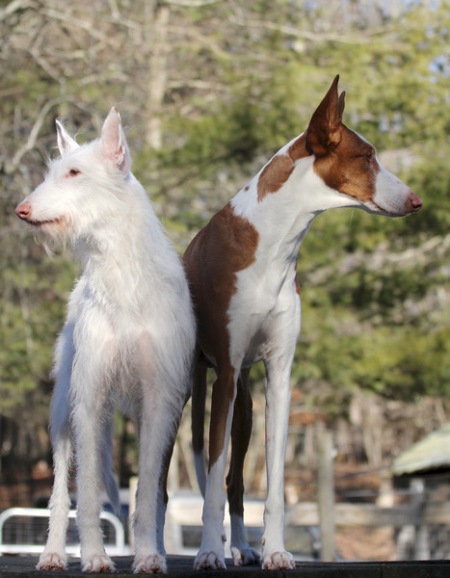 Podenco ibicenco, wirehair and smooth © Aza Photography Podenco Ibicenco (Ibizan) 21 samples were given to the study (no information as to where they came from). The results of these new samples cluster with prior samples (p 36 Dr.Wimmer). They also cluster loosely away from other breeds and other Sighthounds, and other mediterranean breeds with the exception of the Podenco Canario (2 Ibizan samples on the border of the Podenco Canario cluster) (page 34 Dr.Wimmer) 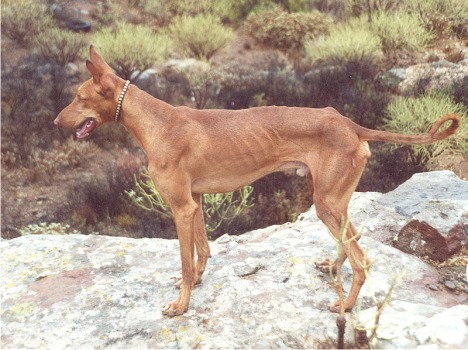 Podenco canario, smooth © Jan Eduard Podenco Canario 23 samples of this breed were given to the study, no information in the German documents as to where they came from. Most of the samples of this breed cluster away from other breeds of dogs, except for 2 samples (page 38 Dr.Wimmer). They form a loose cluster away from other Sighthounds, with proximity to Ibizan (2 Ibizan samples) and Galgo espanol (page 34 Dr.Wimmer) It is interesting that these two similar Podenco breeds should be distinct but at the same time genetically close in this study, as they originate on islands far from each other. The Podenco Ibicenco originates from the Balearic Islands along the eastern coast of the Iberian Peninsula in the Mediterranean sea, whereas the Podenco Canario originates from the Canary islands west of the coast of Morocco in the Atlantic Ocean. One would have expected some Genetic Drift to have occurred between these 2 populations breeding isolated from each other on their respective islands - unless some of the foundation dogs in the samples of these 2 breeds were mistakengly confused with one another, or if there have been some other historical interactions between the Podencos of these 2 sets of islands in the recent past. 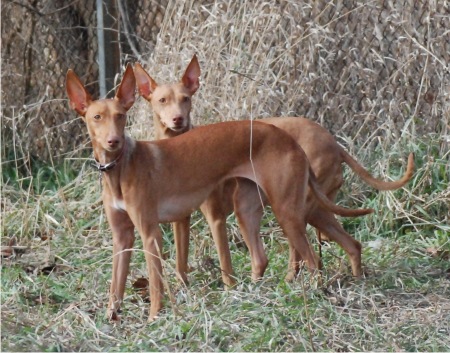 Cirnechi dell'Etna © White Cirneco dell'Etna 23 samples were given to the study (no information as to where they came from). The results of this breed cluster loosely, away from other breeds of dogs (page 38 Dr.Wimmer) and Sighthounds, and away from the Pharaoh Hound except for one sample that is very close to the Pharaoh (page 34 Dr.Wimmer). Selective breeding in the island of Sicily does seem to have resulted to some extent in a separate gene pool for the Cirnechi. 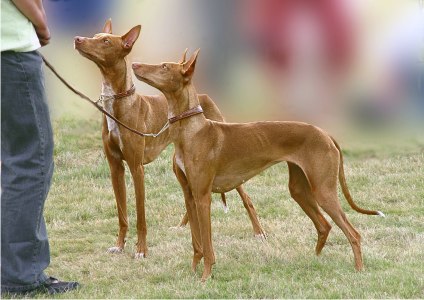 Pharaoh hounds © R. Schwab Pharaoh Hound 25 samples were given to the study (no information as to where they came from). The results of the new samples of this breed cluster loosely with prior samples, away from other breeds of dog (page 38 Dr.Wimmer) and Sighthounds, and away from the Cirneco dell'Etna except for one sample that is very close to the Cirneco (page 34 Dr.Wimmer). Selective breeding on the island of Malta does seem to have resulted to some extent in a separate gene pool for the Pharaoh Hound also. 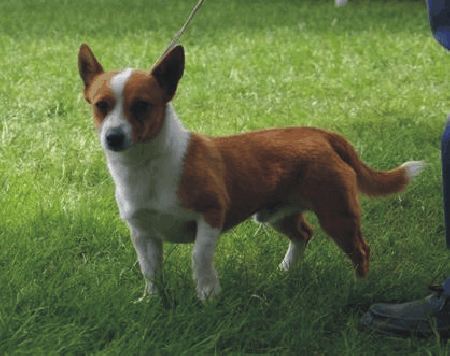 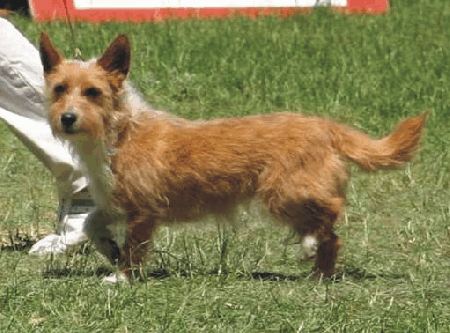 Podenco portugues pequeno, smooth and wirehair © Gaby Assmann Podenco portugues pequeno (small) 25 samples were given to the study (no information given as to where they came from). All were new samples. The results cluster clearly away from the all dog breeds group (page 38 Dr. Wimmer), away from other breeds in the study and also away from the Podenco portugues medio, indicating that selective breeding has taken place for many generations away from what is considered another variety of the breed (page 34 Dr. Wimmer). 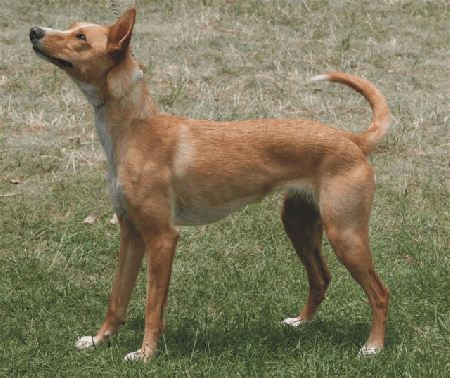 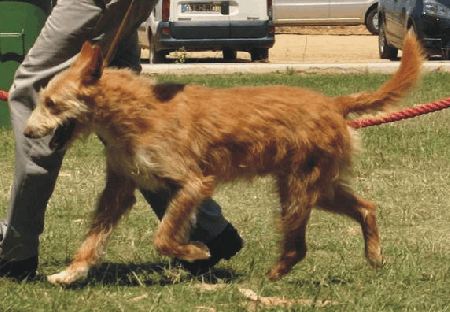 Podenco portugues medio, smooth and wirehair © Gaby Assmann Podenco portugues medio (medium) 21 samples were given to the study (no information as to where they came from). The results show a cluster away from other breeds of dogs and from the Podenco portugues pequeno (page 38 Dr.Wimmer). Interestingly, several samples of the Podenco Portugues medio are found to group between the Sloughi and the Galgo, although several other samples cluster clearly away from the Galgo and the Sloughi, see the summary of Sloughis results (page 5 Arnold). There are too many such samples to be an error in the sampling or laboratory technique itself. As pointed out in the Sloughi results, this would tend to show that at some point in the recent history of these breeds (or the breeding of the dogs tested itself) - Podenco portugues medio, Sloughi and Galgo - some admixture took place, but it is difficult to know in which direction that admixture happened, when, where and in which of the 3 breeds it happened. Summary The Sloughis sampled in this study do not show any close relationship to Middle Eastern Sighthounds, but more to Mediterranean and African breeds. Unfortunately, no samples from Tunisian or Algerian imports, who were raised further away from the Iberian peninsula, are included in this study. Only one Moroccan import sample was sent in, and it is not clear whether it is part of the results. Establishing a data base for North African bred Sloughis would be important to compare the German Sloughis with. Such a data base is essential to verify the position of the Sloughi within Mediterranean breeds. This data base would also enable to assess the closeness to Galgo espanol and Podenco portugues medio in the African bred Sloughis that have no relationshiop to Western bred Sloughis. It would perhaps also shed light as to whether the admixture that is suggested happened a long time ago during the Moors' centuries-long occupation of the Iberian peninsula, or whether it is a recent event that took place in the Western breeding itself. We also await an official peer-reviewed publication of these results in a scientific magazine. Should more details be published in the future we will include them here. Aknowledgements
Many thanks to all who provided pictures either privately or by making them available through Wikimedia Commons. References Original links of the German documents on the DWZRV website Dr. Wimmer's talk Summaries by breed Arnold- Sloughis Arnold- Afghan hound Arnold- Azawakhs Arnold- Borzoi Arnold- Scottish Deerhound Arnold- Galgo espanol Arnold- Greyhound Arnold- Irish Wolfhound Arnold- Saluki Arnold- Italian Greyhound ABOUT THE AUTHOR
|